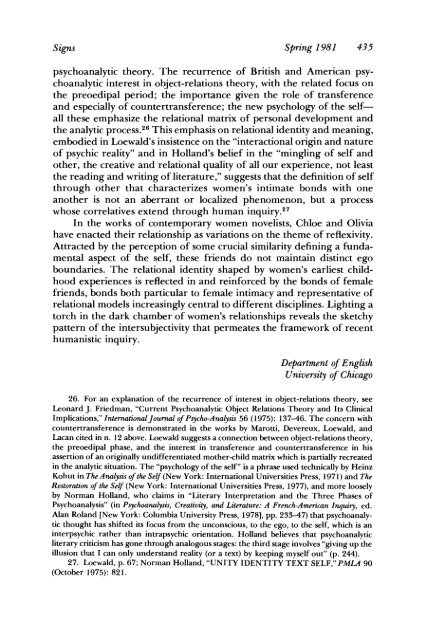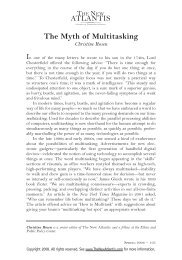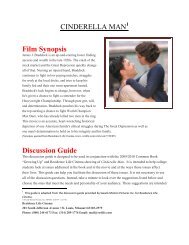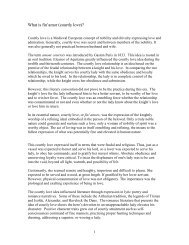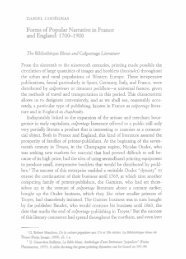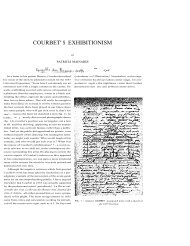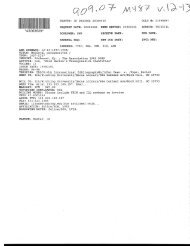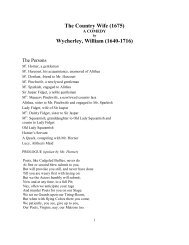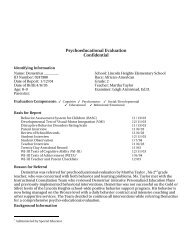(E)Merging Identities: The Dynamics of Female Friendship in ...
(E)Merging Identities: The Dynamics of Female Friendship in ...
(E)Merging Identities: The Dynamics of Female Friendship in ...
You also want an ePaper? Increase the reach of your titles
YUMPU automatically turns print PDFs into web optimized ePapers that Google loves.
Signs Spr<strong>in</strong>g 1981 435<br />
psychoanalytic theory. <strong>The</strong> recurrence <strong>of</strong> British and American psychoanalytic<br />
<strong>in</strong>terest <strong>in</strong> object-relations theory, with the related focus on<br />
the preoedipal period; the importance given the role <strong>of</strong> transference<br />
and especially <strong>of</strong> countertransference; the new psychology <strong>of</strong> the selfall<br />
these emphasize the relational matrix <strong>of</strong> personal development and<br />
the analytic process.26 This emphasis on relational identity and mean<strong>in</strong>g,<br />
embodied <strong>in</strong> Loewald's <strong>in</strong>sistence on the "<strong>in</strong>teractional orig<strong>in</strong> and nature<br />
<strong>of</strong> psychic reality" and <strong>in</strong> Holland's belief <strong>in</strong> the "m<strong>in</strong>gl<strong>in</strong>g <strong>of</strong> self and<br />
other, the creative and relational quality <strong>of</strong> all our experience, not least<br />
the read<strong>in</strong>g and writ<strong>in</strong>g <strong>of</strong> literature," suggests that the def<strong>in</strong>ition <strong>of</strong> self<br />
through other that characterizes women's <strong>in</strong>timate bonds with one<br />
another is not an aberrant or localized phenomenon, but a process<br />
whose correlatives extend through human <strong>in</strong>q~iry.~'<br />
In the works <strong>of</strong> contemporary women novelists, Chloe and Olivia<br />
have enacted their relationship as variations on the theme <strong>of</strong> reflexivity.<br />
Attracted by the perception <strong>of</strong> some crucial similarity def<strong>in</strong><strong>in</strong>g a fundamental<br />
aspect <strong>of</strong> the self, these friends do not ma<strong>in</strong>ta<strong>in</strong> dist<strong>in</strong>ct ego<br />
boundaries. <strong>The</strong> relational identity shaped by women's earliest childhood<br />
experiences is reflected <strong>in</strong> and re<strong>in</strong>forced by the bonds <strong>of</strong> female<br />
friends, bonds both particular to female <strong>in</strong>timacy and representative <strong>of</strong><br />
relational models <strong>in</strong>creas<strong>in</strong>gly central to different discipl<strong>in</strong>es. Light<strong>in</strong>g a<br />
torch <strong>in</strong> the dark chamber <strong>of</strong> women's relationships reveals the sketchy<br />
pattern <strong>of</strong> the <strong>in</strong>tersubjectivity that permeates the framework <strong>of</strong> recent<br />
humanistic <strong>in</strong>quiry.<br />
Department <strong>of</strong> English<br />
University <strong>of</strong> Chicago<br />
26. For an explanation <strong>of</strong> the recurrence <strong>of</strong> <strong>in</strong>terest <strong>in</strong> object-relations theory, see<br />
Leonard J. Friedman, "Current Psychoanalytic Object Relations <strong>The</strong>ory and Its Cl<strong>in</strong>ical<br />
Implications," International Journal <strong>of</strong>psycho-Analysis 56 (1975): 137-46. <strong>The</strong> concern with<br />
countertransference is demonstrated <strong>in</strong> the works by Marotti, Devereux, Loewald, and<br />
Lacan cited <strong>in</strong> n. 12 above. Loewald suggests a connection between object-relations theory,<br />
the preoedipal phase, and the <strong>in</strong>terest <strong>in</strong> transference and countertransference <strong>in</strong> his<br />
assertion <strong>of</strong> an orig<strong>in</strong>ally undifferentiated mother-child matrix which is partially recreated<br />
<strong>in</strong> the analytic situation. <strong>The</strong> "psychology <strong>of</strong> the self" is a phrase used technically by He<strong>in</strong>z<br />
Kohut <strong>in</strong> <strong>The</strong> Analysis <strong>of</strong>the Self (New York: International Universities Press, 1971) and <strong>The</strong><br />
Restoration <strong>of</strong>the Self (New York: International Universities Press, 1977), and more loosely<br />
by Norman Holland, who claims <strong>in</strong> "Literary Interpretation and the Three Phases <strong>of</strong><br />
Psychoanalysis" (<strong>in</strong> Psychoanalysis, Creativity, and Literature: A French-American Inquiry, ed.<br />
Alan Roland [New York: Columbia University Press, 19781, pp. 233-47) that psychoanalytic<br />
thought has shifted its focus from the unconscious, to the ego, to the self, which is an<br />
<strong>in</strong>terpsychic rather than <strong>in</strong>trapsychic orientation. Holland believes that psychoanalytic<br />
literary criticism has gone through analogous stages: the third stage <strong>in</strong>volves "giv<strong>in</strong>g up the<br />
illusion that I can only understand reality (or a text) by keep<strong>in</strong>g myself out" (p. 244).<br />
27. Loewald, p. 67; Norman Holland, "UNITY IDENTITY TEXT SELF,"PMLA 90<br />
(October 1975): 821.


